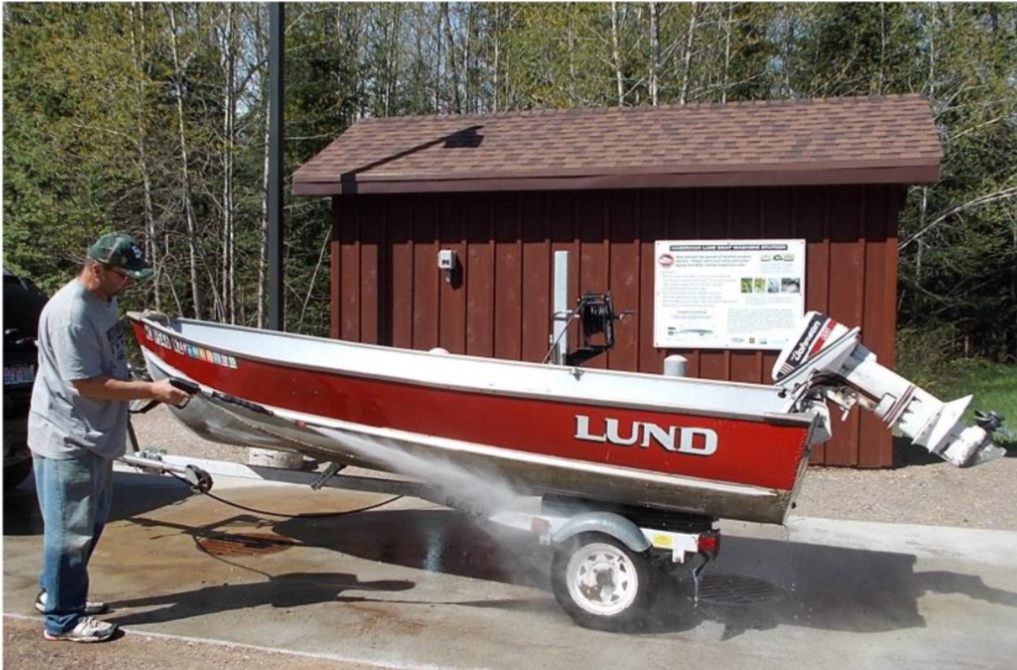Biosecurity is about reducing the risk of introducing or spreading invasive non-native species (and other things like diseases) in the countryside.
Species and diseases can spread by hitchhiking on boat hulls, paddleboards, windsurf boards, fishing rods, bike tyres, walking boots, wellies, survey equipment and even dog paws! When we visit a different place, these often-invisible hitchhikers can be transferred and can become established in a new location, sometimes with devastating effects. Gardeners also need practice good biosecurity and not allow plants to spread into the wild, and dispose of garden plants and compost with care.
With good biosecurity routines we can all do our bit to reduce and minimise the spread of invasive species, pests and diseases, and stop the spread!

What should you do?
Everyone can follow a basic biosecurity routine, as a matter of course;
- Arrive with clean, dry footwear and equipment.
- CHECK – Before leaving a site
- Visually check footwear, boards, boat hulls and equipment for debris - plant and animal matter, small organisms, soil, seeds etc. and remove. Carry a basic biosecurity kit (brush and water) to help remove debris while on site.
- Ideally rinse all your kit on site to ensure all debris is removed - remember some diseases aren't visible to the human eye and you might not recognise an invasive plant!
- Drain any trapped water from inside kayaks and canoes

-
CLEAN - Clean and wash footwear, clothing and equipment with appropriate disinfectants, ideally on site, where the washings should be left. If this is not possible bag your gear carefully and wash as soon as possible, but do not let the washings enter any watercourse or drains.
- DRY - dry your kit and clothing thoroughly, some species can live weeks in damp, moist conditions.
Read more about biosecurity

Anglers
Many aquatic invasive species and diseases are impossible to see and easily transferred from one water body to another on waders, rods, nets and boats. Follow the CHECK, CLEAN, DRY guidance for anglers, and ensure you are aware of which invasive species to watch out for.
Download the Anglers Check Clean Dry leaflet.

Sailors and Paddlers
Invasive species or diseases can be spread in any water or material clinging to water sports equipment. Users of boats, kayaks, canoes, paddleboards etc. should take care to avoid moving invasive species or material between water bodies.
Follow the CHECK, CLEAN, DRY guidance for boat users or guidance for paddlers ensure boats, boards & trailers are cleaned, including removing biofouling from hulls before transfer to another site. Wetsuits, buoyancy aids and boots also need a good clean.
British Canoeing have put together handy video guides covering good biosecurity practices for canoes, kayaks and paddleboards.
Download the Boating Check Clean Dry leaflet
Download the Canoe, Kayak & Stand Up Paddle Boarding Check Clean Dry leaflet

Event organisers
Outdoor event organisers can play a key part in improving biosecurity and protecting the environment. Participants should be asked to arrive at the event with their kit clean and dry. A cleaning station should be set up for those that arrive with damp or dirty kit and for use after the event.
Download the Scottish Event Biosecurity Support Pack

Walkers & mountain bikers
We love exploring the countryside but we need to take responsibility for being bio-secure. As well as the risk of spreading aquatic organisms if walking near rivers, there is a risk of spreading tree pests and diseases. Tree pests and diseases, can easily hitch a ride in mud and debris on shoes, paws and tyres, ending up in new forests. Read more about how you can Keep it Clean.

Gardeners & pond owners
Follow the Be Plant Wise guidance to ensure you don’t allow aquatic or garden plants to escape into the countryside and find out how to Compost with Care. Lots of advice is available to allow you to garden with native species alternatives.
Booklets to download;
Each Fishery Trust/Board that looks after the river environment also has a Biosecurity Management Plan which covers the prevention, detection and control of aquatic, riparian and marine invasive non-native species and fish diseases within a river catchment.
